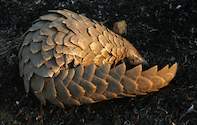
About the Skukuza Area
At Skukuza Camp
Paul Kruger Gate
Phabeni Gate
Phabeni to Skukuza
Rhino Koppies Route
Sabie Sands Loop
Skukuza to Lower Sabie
Skukuza to Satara
Tshokwane and Surrounds
Tshokwane to Lower Sabie
Tshokwane to Satara
See Kruger Park Skukuza Area Self-drive Map
Tshokwane to Lower Sabie (H10)

The road from Tshokwane to Lower Sabie is a wonderfully scenic drive through the Lebombo hills and down into the south-eastern grasslands. The drive should include a detour to Orpen Dam (4km west, off the S32) with stopoffs at Nkumbe Lookout Point, Mlondozi Dam and Muntshe Hill.
Orpen is a water hole on the N'waswitsontso River on the edge of the Lebombo with a fine view over the koppies and thick woodlands. In Shangaan, n'waswitsontso means either to "drip intermittently" or "the river that runs under the sand", alluding to the sporadic nature of the river's flow.
For most of the year, the N'waswitsontso is a dry stream bed, but this appears deceptive as there seems to be a perennial underground stream beneath the sandbanks.
Elephants often dig drinking holes in the river during the dry season to get to the underground water.
The river, which winds for more than 100km through Kruger from Talamati Camp across the south central woodlands, was first referred to in writing by the earliest Dutch visitor to Kruger, Francois de Kuiper. He noted it in his diary in 1725 as the Matindonde River. Beyond Nkumbe, the road drops out of the Lebombo and crosses the eastern savanna plains towards Lower Sabie.
There are several excellent birding spots on the road, including the vleis at the foot of Muntshe Hill, Mlondozi Dam and the Sabie River crossing just below the camp.Madness and Malaria

The Trichardt voortrekker party began their tortuous route through the escarpment in early December 1837. As anyone who has spent a rainy summer in the northern Drakensberg will attest, this is a particularly bad time to attempt such an undertaking. The weather was terrible - storms and incessant rain made the descent through the thick bush of the escarpment gorges a misery.
They clambered, slithered, quarrelled and prayed their way down through the slippery mud and impenetrable bush between the granite outcrops. Their pace was painfully slow and they found themselves stuck for days at a time. Christmas was the Christmas from Hell. They woke up to find that three of the teenage boys had deserted in the middle of the night, taking guns, food and ammunition. Not only did this deplete valuable supplies, but it reduced the amount of muscle-power available to lower the cumbersome wagons, stock and equipment down the mountain.
Four days later, the three boys sheepishly returned, after realising their chances of survival were significantly enhanced by staying with the group. They paid a price - one of the elders, Tannie Scheepers, made it her personal duty to sjambok all three with every ounce of strength her body could muster. It took Trichardt's party two months and 10 days to lower their nine wagons down the escarpment to the lowveld, which they reached at the end of January 1838. Louis Trichardt wrote in his diary that the day they reached the sycamore fig at the foot of the mountain was the happiest day of his life. However, his troubles were only beginning. Little did Trichardt know that his journey through the lowveld and coastal flatlands held a deadly surprise.
He thought his main threat would be hostility from the Sekororo - the local community made up of a number of disparate clans that had settled in the area after the upheavals of Zulu expansionism in the early 19th century. To neutralise this threat, he took a Middle-Eastern type of gamble and kidnapped a small group of Shangaan men and women. He promised to release his hostages once he got to the Lebombo. Either the hostage strategy worked, or the spirit of ubuntu prevailed, or they were kept safe by the rumour that white men brought nothing but bad luck and the sooner one saw the back of them, the better.
At all the homesteads they encountered, they were treated courteously and presented with a good deal of marula beer. The hostages were freed at the Lebombo and Trichardt's party crossed into present-day Mozambique through the N'wasitsontso gorge. They were enthusiastically received by the governor of Portuguese East Africa when they reached Delagoa Bay on April 13, 1838 but he nonetheless deemed it prudent to confiscate their weapons.
Their joy at reaching the coast soon turned to grief as they realised that their main enemy had not been the Sekororo but the anopheles mosquito. Half the party had contracted malaria and, within months, 27 of them died, including Louis Trichardt himself. As the historian TV Bulpin remarked rather gloomily of the expedition,
"Like many another human tale, hope marked its beginning - tears marked its end".
Flight of the Falcons

A good time to visit Nkumbe is in late summer when falcons and kestrels gather in huge flocks to build condition before they fly off on their long northern migration to eastern Asia. Most of these are amur (eastern red-footed kestrel) and lesser kestrels.
The exact migration route of the amur remains a mystery - while they are well documented passing over northern India at the start of their journey southwards, they are not seen in this area on the return trip, prompting speculation that they cross the Indian Ocean and then head over the Himalayas back to their Siberian breeding grounds.

 From Lower Sabie Camp you have the opportunity to watch the endless procession of animals coming to drink at the Sabie River. Visitors canno...
From Lower Sabie Camp you have the opportunity to watch the endless procession of animals coming to drink at the Sabie River. Visitors canno...